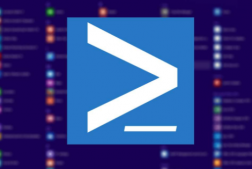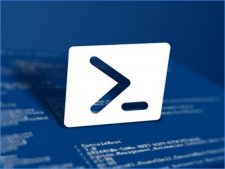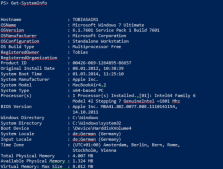前言
PowerShell能干什么呢?PowerShell首先是个Shell,定义好了一堆命令与操作系统,特别是与文件系统交互,能够启动应用程序,甚至操纵应用程序;第二,PowerShell允许将几个命令组合起来放到文件里执行,实现文件级的重用,也就是说有脚本的性质;第三,PowerShell能够能够充分利用.Net类型和COM对象,来简单地与各种系统交互,完成各种复杂的、自动化的操作。
当我们习惯了windows的界面模式就很难转去命令行,甚至以命令行发家的git也涌现出各种界面tool。然而命令行真的会比界面快的多,如果你是一个码农。
situation:接到需求分析bug,需要访问http。那台机器属于product,不允许装postman。我只能手动命令行来发请求。发现了内置的PowerShell中有curl命令。欢喜试了半天,总是命令不对,google发现这个curl是冒名顶替的,只是一个Invoke-WebRequest的alias。参考。
|
1
2
3
4
5
6
7
|
PS> Get-Alias -Definition Invoke-WebRequest | Format-Table -AutoSizeCommandType Name Version Source----------- ---- ------- ------Alias curl -> Invoke-WebRequestAlias iwr -> Invoke-WebRequestAlias wget -> Invoke-WebRequest |
Invoke-WebRequest简单用法
1.用途
|
1
|
Gets content from a web page on the Internet. |
获取http web请求访问内容
2.语法Syntax
|
1
2
|
Parameter Set: DefaultInvoke-WebRequest [-Uri] <Uri> [-Body <Object> ] [-Certificate <X509Certificate> ] [-CertificateThumbprint <String> ] [-ContentType <String> ] [-Credential <PSCredential> ] [-DisableKeepAlive] [-Headers <IDictionary> ] [-InFile <String> ] [-MaximumRedirection <Int32> ] [-Method <WebRequestMethod> {Default | Get | Head | Post | Put | Delete | Trace | Options | Merge | Patch} ] [-OutFile <String> ] [-PassThru] [-Proxy <Uri> ] [-ProxyCredential <PSCredential> ] [-ProxyUseDefaultCredentials] [-SessionVariable <String> ] [-TimeoutSec <Int32> ] [-TransferEncoding <String> {chunked | compress | deflate | gzip | identity} ] [-UseBasicParsing] [-UseDefaultCredentials] [-UserAgent <String> ] [-WebSession <WebRequestSession> ] [ <CommonParameters>] |
3.简单的几个用法
3.1 Get请求
|
1
2
3
4
5
6
7
8
9
10
11
|
PS C:\Users\rmiao> curl -URi https://www.google.comStatusCode : 200StatusDescription : OKContent : <!doctype html><html itemscope="" itemtype="http://schema.org/WebPage" lang="en"><head><meta content="Search the world's information, including webpages, images, videos and more. Google has many speci..."RawContent : HTTP/1.1 200 OK X-XSS-Protection: 1; mode=block X-Frame-Options: SAMEORIGIN Alt-Svc: quic=":443"; ma=2592000; v="36,35,34,33,32" Vary: Accept-Encoding Transfer-Encoding: chunked |
会发现content内容被截断了。想要获取完整的content:
|
1
|
ps> curl https://www.google.com | Select -ExpandProperty Content |
3.2添加header
|
1
|
-Headers @{"accept"="application/json"} |
3.3指定Method
|
1
|
-Method Get |
3.4将获取到的content输出到文件
|
1
|
-OutFile 'c:\Users\rmiao\temp\content.txt' |
3.5表单提交
|
1
2
3
4
5
|
For example:$R = Invoke-WebRequest http://website.com/login.aspx $R.Forms[0].Name = "MyName"$R.Forms[0].Password = "MyPassword"Invoke-RestMethod http://website.com/service.aspx -Body $R |
or
|
1
|
Invoke-RestMethod http://website.com/service.aspx -Body $R.Forms[0] |
3.6内容筛选
|
1
2
3
4
5
6
7
8
9
10
11
|
PS C:\Users\rmiao> $R = Invoke-WebRequest -URI http://www.bing.com?q=how+many+feet+in+a+milePS C:\Users\rmiao> $R.AllElements | where {$_.innerhtml -like "*=*"} | Sort { $_.InnerHtml.Length } | Select InnerText -First 5innerText---------=1Next= |
3.7一个登陆示例
|
1
2
3
4
5
6
7
8
9
10
11
12
13
14
15
16
17
18
19
20
21
22
23
24
25
26
27
28
29
30
31
32
33
34
35
36
37
38
39
40
41
42
43
44
45
46
47
48
49
50
51
52
53
54
55
56
57
58
59
60
61
62
63
64
65
66
|
#发送一个登陆请求,声明一个sessionVariable 参数为fb, 将结果保存在$R#这个变量FB就是header.cookie等集合PS C:\Users\rmiao> $R=curl http://www.facebook.com/login.php -SessionVariable fbPS C:\Users\rmiao> $FBHeaders : {}Cookies : System.Net.CookieContainerUseDefaultCredentials : FalseCredentials :Certificates :UserAgent : Mozilla/5.0 (Windows NT; Windows NT 6.3; en-US) WindowsPowerShell/4.0Proxy :MaximumRedirection : -1#将response响应结果中的第一个form属性赋值给变量FormPS C:\Users\rmiao> $Form=$R.Forms[0]PS C:\Users\rmiao> $Form.fieldsKey Value--- -----lsd AVqQqrLWdisplayenable_profile_selectorisprivatelegacy_return 0profile_selector_idsreturn_sessionskip_api_loginsigned_nexttrynum 1u_0_0u_0_1lgnrnd 214945_qGeglgnjs nemailpasspersistentdefault_persistent 1# 查看formPS C:\Users\rmiao> $Form | Format-ListId : login_formMethod : postAction : /login.php?login_attempt=1&lwv=100Fields : {[lsd, AVqQqrLW], [display, ], [enable_profile_selector, ], [isprivate, ]...}#查看属性$Form.fields#设置账号密码$Form.Fields["email"] = "User01@Fabrikam.com"$Form.Fields["pass"] = "P@ssw0rd"#发送请求并保存结果为$R$R=Invoke-WebRequest -Uri ("https://www.facebook.com" + $Form.Action) -WebSession $FB -Method POST -Body $Form.Fields#查看结果PS C:\Users\rmiao> $R.StatusDescriptionOK |
虽然没有curl那么主流,但一样可以成为http访问的一个选择。
总结
以上就是这篇文章的全部内容了,希望本文的内容对大家的学习或者工作能带来一定的帮助,如果有疑问大家可以留言交流,谢谢大家对服务器之家的支持。
参考
https://technet.microsoft.com/en-us/library/hh849901.aspx
原文链接:http://www.cnblogs.com/woshimrf/p/5899629.html







